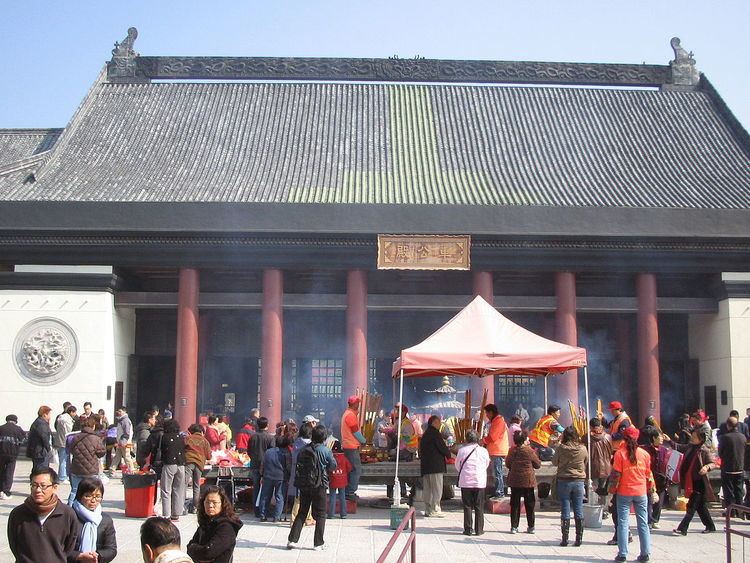Phone +852 2603 4049 | ||
 | ||
Address 7 Che Kung Miu Rd, Tai Wai Sha Tin, Hong Kong Similar Tai Wai Station, Hau Wong Temple, Yuk Hui Temple, Chegongmiao Station, Che Kung Temple at Ho Chung | ||
Che kung temple a brief intro version 3
Che Kung Miu (Chinese: 車公廟; pinyin: Chēgōng Miào), also called Che Kung Temple, are temples dedicated to Che Kung, who was a general during the Southern Song Dynasty (1127–1279) in ancient China. He is believed by some worshipers to have been involved in the attempt to keep the Song state alive by bringing Prince Ping and his brother to the South. There are two temples dedicated to Che Kung in Hong Kong: one in Sha Tin and one in Ho Chung. Other temples in Hong Kong are partly dedicated to Che Kung.
Contents
- Che kung temple a brief intro version 3
- Hong kong che kung temple
- Sha Tin
- Ho Chung
- Other temples
- Festivals
- References
Hong kong che kung temple
Sha Tin
The Che Kung Miu near Tai Wai, in Sha Tin District, New Territories, is the best known example in Hong Kong. During the second and the third days of Lunar New Year, thousands of people go to this temple to worship, including many local Hong Kong government officials. This temple, on Che Kung Miu Road (車公廟路), is located midway between Tai Wai and Che Kung Temple stations of the MTR.
According to as story, during an epidemic that broke out in Sha Tin in the late Ming dynasty (1368–1644), possibly the epidemic of 1629, local residents found out from historical writings that Che Kung was not only merited for his successful suppression of uprisings, but was also known for clearing epidemics wherever he set foot in. People therefore built a temple to house Che Kung in Sha Tin, and the epidemic subsided on the day the construction of the temple was completed. According to oral traditions, the Che Kung Temple at Sha Tin was founded from Ho Chung, when the god was "invited" from the existing Che Kung Temple in Ho Chung to Sha Tin.
The original temple was first built at the end of the Ming Dynasty and was renovated in 1890, 1993 and 2004. The external walls are now plastered with false brick lines and the roofs with green glazed ceramic tiles. The recent renovation is considered to have "very much diminished the authenticity of temple". Due to the high number of worshipers during the Che Kung Festival following the Lunar New Year, a new temple was built in 1994 in front of the original one. The original temple has been preserved in-situ; it is only occasionally open to the public. It is classified as a Grade II historic building since 1987.
The current Che Kung temple, in Japanese-style, was built in 1993–1994 at a cost of HK$48 million. It is eight times the size of the old one. The main hall contains a giant statue of Che Kung. Next to it is a fan-bladed wheel of fortune, which, worshippers believe, will bring good luck when turned three times. Fortune-tellers can be found within the temple.
The Che Kung Temple was built and initially managed by the Tin Sam village of Tai Wai. The village lost its managerial rights in the late 19th century in a lawsuit against the Kau Yeuk (九約, "Alliance of Nine" [villages]), a regional organization of various groups in Sha Tin Valley, since the latter had provided evidence that it made significant contributions to the renovation of the temple. The temple was subsequently jointly managed by nine villages of Sha Tin, while the Tin Sam village continued to enjoy some privileges in the worship of Che Kung. Since 1936, the temple has been administered by the Chinese Temples Committee. Admission to the temple is free, but it is customary for visitors to donate money to support the maintenance of the temple. Its opening hours are 7:00am to 6:00pm daily. Since 2013, the courtyard of the temple can be visited with Google Street View.
Ho Chung
Situated on the banks of the Ho Chung River, and half a mile from Ho Chung Village in Sai Kung District, the temple is one of the oldest in Hong Kong and worship General Che, his son and his grandson. Initially built in the mid-16th century, the temple predates its popular counterpart near Tai Wai in Sha Tin District, which is said to worship the grandson of General Che. The present temple structure probably dates largely from 1878, while the temple furniture probably dates from the Xianfeng era (1850–1861).
It is great place to be for Chinese New Year, as the spirit of Che Kung is celebrated alongside memories of family members that have passed to the next life.
Other deities worshipped at the temple include Hung Shing, Tin Hau and Choi Pak Shing Kun (財帛星君).
Run by villagers for over 300 years, the temple is now being kept by Wan Sai Cheung of the Wan family who have been residents in Ho Chung village for many generations. While the temple has been renovated several times, it is considered that "the authenticity [of the building] is in general kept". Known renovation dates include 1908, 1994 and 2002, while other sources also mention 1934 and 2000. It was listed as a Grade II historic building in 1996, and as a Grade I historic building in 2009.
Other temples
Other temples in Hong Kong are partly dedicated to Che Kung. These include:
Festivals
There are four annual Che Kung Festivals (車公誕):
